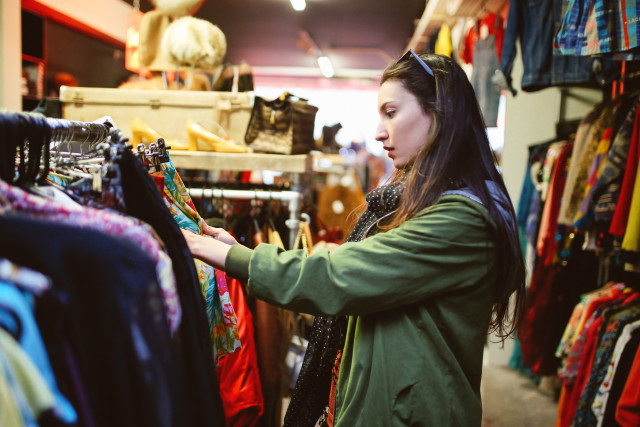Fashion trends come and go, but the way people prefer to invest in new clothing has largely remained the same over the past few decades—until just recently. Online shopping has brought a whole new element of convenience to the experience, of course, but that’s just the beginning. Increasingly, young shoppers take pride in finding unique secondhand items in thrift stores and through various smartphone applications.
This trend isn’t just speculation; it’s borne out by record numbers in the resale industry. For example, thredUP’s 2018 Fashion Resale Report projects that the resale market will reach a total value of $41 billion by 2022, with apparel representing nearly half of these purchases. Already, a significant share of the population is dedicated to thrifting, with 44 million having shopped secondhand in 2017—versus just 35 million in 2016.
The secondhand revolution can tell us a lot about upcoming changes to the fashion industry at large. Below, we examine why this sector is growing so quickly—and how digital solutions will play into the industry’s future.
Why Shoppers Love Secondhand Apparel
Eco-Friendly Clothing
Shoppers increasingly understand the impact their everyday purchases can have on the environment. According to Diane McCrohan, professor and online instructor at Johnson & Wales, fashion is the second-dirtiest industry in the world behind oil. Seventy-seven percent of thredUp respondents told the company that they prefer making clothing purchases from eco-conscious brands, although not all manage to live up to this ideal. McCrohan regards thrifting as an effective means of living out ones environmental impulses. “Many people want to buy environmentally friendly clothes but many clothing items in this category price themselves out of your average consumer’s disposable income,” she said. “Buying clothing secondhand makes it much more affordable.”
Supporting Local Businesses and Individual Sellers
While vast resale chains abound, many stores are locally owned and operated. Shoppers enjoy supporting these businesses while scoring unique finds that they won’t find at typical big box stores or even on Amazon. Many of these businesses sell upcycled clothing—used apparel that has been amped up with screen printing, special stitching, bedazzling, or other details.
Online platforms such as Poshmark may focus less on the local element, but still allow shoppers to support real people, who can apply funds generated from clothing sales towards everything from college savings to new outfits. Some online sellers manage to produce a dedicated following, while others rely on digital marketplaces as occasional wardrobe cleanup solutions.
Personal Style
If fashion is all about personal expression, it stands to reason that shoppers might gravitate towards looks they haven’t yet seen replicated by their friends. Such looks are easier to find secondhand; a combination of classics and resurfaced trends can be relied upon to create aesthetics that are both unique and in keeping with modern style.
Going beyond physical locations, Poshmark and other resale apps provide instant access to an endless array of items that can easily be organized by brand, size, and color. This approach appeals to fashion lovers with very specific tastes—and those who previously struggled to find items they truly loved in traditional thrift stores.
Novelty
A deep-seated love of novelty plays a huge role in the modern resale industry. Today’s fashion devotees enjoy trying on and showing off new outfits—and many abhor the very idea of wearing the exact same look twice. Some have realized that, by investing in thrifted apparel, they can pursue their desire for fashion-based novelty while minimizing both the cost and the effect on the environment. “People are using luxury second-hand clothing to replace fast fashion,” explained McCrohan. “It has value and by buying secondhand, it is less harmful to the environment.”
Social media may play a significant role in the constant pursuit of novel clothing. In the report Rise of the Fashion Resale Marketplace, experts from the Raymond James Financial Center cite the ‘desire for frequent turnover of wardrobes, especially among the Instagram generation.’
Thrift shoppers increasingly highlight their finds on Instagram and Facebook, while secondhand hauls generate millions of views on YouTube influencer channels. Shoppers are not afraid to let followers know that their favorite items were purchased second hand; many posts purposefully tag apps such as Poshmark and thredUP. On the seller side, many influencers share items for sale on personal Instagram pages, which attract significant followings.
Convenience
Secondhand apparel is more accessible than ever before. Thrift stores and vintage boutiques abound, but they are far from the only options available. Many dedicated thrifters throw swap events, in which they exchange no longer needed items with fellow thrifters in hopes of scoring great finds at minimal cost. Others prefer to find specific brands, styles, or sizes via digital marketplaces. “The internet makes it very easy for consumers to shop secondhand,” said McCrohan.
Pursue a Career in Fashion Merchandising & Retail
Johnson & Wales University offers the opportunity to stay on top of resale apparel and other groundbreaking fashion trends via its Bachelor of Science in Fashion Merchandising & Retail program. This online option prepares students for a variety of exciting career paths. Reach out today to learn more.
For more information about completing your degree online, complete the Request Info form, call 855-JWU-1881, or email [email protected].
